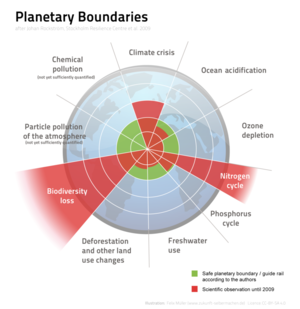Ecological crisis: Difference between revisions
From BurnZero
No edit summary |
No edit summary |
||
| Line 1: | Line 1: | ||
[[File:Planetary Boundaries.png|alt=Planetary Boundaries|thumb|Planetary Boundaries]] | [[File:Planetary Boundaries.png|alt=Planetary Boundaries|thumb|Planetary Boundaries]] | ||
'''In the 1960s, humans took about three-quarters of what the planet could regenerate annually. By 2016 this rose to 170 percent, meaning that the planet cannot keep up with human demand, and we are running the world down.''' | '''In the 1960s, humans took about three-quarters of what the planet could regenerate annually. By 2016 this rose to 170 percent, meaning that the planet cannot keep up with human demand, and we are running the world down.'''<ref>https://e360.yale.edu/features/avoiding-a-ghastly-future-hard-truths-on-the-state-of-the-planet</ref> | ||
''The world won't end tomorrow, next year or the year after. But it will get progressively worse, each day we do nothing we roll a dice where the probability of something seriously bad happening goes up and up. We have already seen the following:'' | ''The world won't end tomorrow, next year or the year after. But it will get progressively worse, each day we do nothing we roll a dice where the probability of something seriously bad happening goes up and up. We have already seen the following:'' | ||
Revision as of 22:19, 23 February 2022
In the 1960s, humans took about three-quarters of what the planet could regenerate annually. By 2016 this rose to 170 percent, meaning that the planet cannot keep up with human demand, and we are running the world down.[1]
The world won't end tomorrow, next year or the year after. But it will get progressively worse, each day we do nothing we roll a dice where the probability of something seriously bad happening goes up and up. We have already seen the following:
- Climate change - since records began in 1880, nineteen of the twenty hottest years have occurred since 2000[2].
- Biodiversity loss - there has been a 68% average decline in the population sizes of mammals, birds, amphibians, reptiles, and fish between 1970 and 2016[3].
- Deforestation - more than half the world’s tropical forests have been destroyed since the 1960s[4].
- Ocean acidification - more CO2 in the atmosphere means more acidity in the oceans.
- Ozone depletion
- Microplastics via overconsumption.
- the nitrogen cycle
- the phosphorus cycle
These issues combined are accelerating us towards collapse.
References
- ↑ https://e360.yale.edu/features/avoiding-a-ghastly-future-hard-truths-on-the-state-of-the-planet
- ↑ NASA, Global Temperature: https://climate.nasa.gov/vital-signs/global-temperature/
- ↑ IPBES, Media Release, Nature’s Dangerous Decline ‘Unprecedented’; Species Extinction Rates ‘Accelerating’ May 2019
- ↑ International Union for Conservation of Nature. (2021, February). Deforestation and forest degradation. https://www.iucn.org/resources/issues-briefs/deforestation-and-forest-degradation
